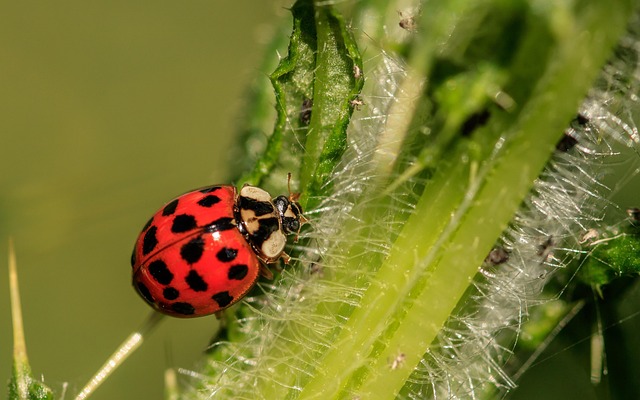Carpet beetles cause damage during their larval stage, so understanding their metamorphosis is key for treatment. Eco-friendly solutions include regular vacuuming, natural deterrents, steam cleaning, and professional integrated pest management (IPM). Prevention involves cleaning, using natural repellents, storing items in airtight containers, and opening windows to reduce humidity. DIY methods like essential oils, vinegar sprays, baking soda, and HEPA filters are effective, but professionals offer specialized eco-friendly solutions for severe infestations, targeting larvae and eggs with minimal environmental impact.
Carpet beetles can wreak havoc on your home’s soft furnishings, leaving behind a trail of damage. But don’t panic! This comprehensive guide offers effective treatments for eliminating these pesky intruders. We’ll first demystify their behavior and life cycle, then present an array of eco-friendly prevention strategies to keep them at bay. For natural solutions, we explore both DIY remedies and homeopathic approaches. When DIY methods fall short, discover professional treatment options tailored to severe infestations. Unlock the secrets to a beetle-free haven with these powerful yet eco-conscious carpet beetle solutions.
Understanding Carpet Beetles: Behavior and Life Cycle
Carpet beetles, despite their innocuous appearance, can cause significant damage to fabrics and carpets. Understanding their behavior and life cycle is crucial in implementing effective treatment methods. These insects go through a complete metamorphosis, starting as eggs laid by female adults, which then hatch into larvae. The larvae are the destructive stage, feasting on organic materials like natural fibers in carpets, fabrics, and even upholstery. They spin silken webs to trap their prey, burrowing deep within textiles. This hidden nature makes detection difficult until a substantial infestation develops.
Knowing their life cycle helps when considering eco-friendly carpet beetle solutions. Since beetles prefer dark, undisturbed areas, regular vacuuming can help prevent infestations. Natural deterrents like lavender, cedar, and tea tree oil can also be effective repellents. When an infestation does occur, isolated treatment with eco-friendly insecticides or steam cleaning is recommended to target larvae without harming the environment. Professional services offering integrated pest management (IPM) methods are another sustainable option, focusing on long-term prevention and control rather than harsh chemicals.
Eco-Friendly Prevention Strategies for Carpet Beetle Infestations
To prevent carpet beetle infestations, consider adopting eco-friendly strategies that promote a healthy home environment. Regular cleaning and vacuuming are fundamental, focusing on areas where wool or fabric items are stored. This helps remove natural debris and larvae before they can mature. Using non-toxic, natural repellents like lavender, cedarwood oil, or white vinegar can also deter carpet beetles naturally.
Additionally, maintaining good air circulation by opening windows periodically allows fresh air to circulate, reducing humidity levels that encourage beetle growth. Storage of woolen items in airtight containers and regular inspection for any signs of infestation are additional eco-friendly measures. These simple yet effective practices create an inhospitable environment for carpet beetles, promoting a healthier and pest-free living space.
Natural Remedies and Home Remedies to Combat Carpet Beetles
Many homeowners prefer natural and eco-friendly carpet beetle solutions over traditional chemical treatments. These methods can be just as effective in combating infestations while minimizing potential health risks and environmental impact. One popular eco-friendly option is using essential oils like lavender, tea tree, or peppermint oil. These powerful aromatics repel carpet beetles due to their strong scent, acting as a natural barrier against them.
Home remedies also offer simple yet effective treatments. For instance, mixing equal parts vinegar and water can create a spray that disrupts the beetle’s pH balance, making it harder for them to survive. Another simple remedy involves sprinkling baking soda or diatomaceous earth across affected areas; these substances dehydrate and kill beetles over time. Regular vacuuming with a HEPA filter bag also helps remove larvae and eggs, preventing further infestation.
Professional Treatment Options: When DIY Methods Fall Short
When do-it-yourself (DIY) methods fall short in tackling a carpet beetle infestation, it’s time to turn to professional treatment options. Professional pest control services offer advanced and specialized eco-friendly carpet beetle solutions that are tailored to the specific needs of your home or business. These treatments often involve a combination of targeted pesticides, dusts, and natural deterrents applied by trained specialists who know exactly where to look for hidden larvae and eggs.
Unlike DIY approaches which may only provide temporary relief, professional interventions aim for complete elimination and prevention. By understanding the life cycle of carpet beetles and employing modern, safe methods, professionals can eradicate infestations while minimizing environmental impact. This is particularly important when dealing with eco-friendly carpet beetle solutions that are both effective and non-toxic to pets and humans.
In addressing carpet beetle infestations, a multi-faceted approach combining understanding, prevention, and treatment options is key. While professional treatments offer robust solutions, eco-friendly strategies and natural remedies provide sustainable, non-toxic alternatives. By understanding the behavior and life cycle of carpet beetles, individuals can effectively navigate and prevent future infestations using simple, accessible tools. Ultimately, a combination of these methods ensures a clean, pest-free environment, showcasing that eliminating carpet beetles need not come at the cost of environmental health.
